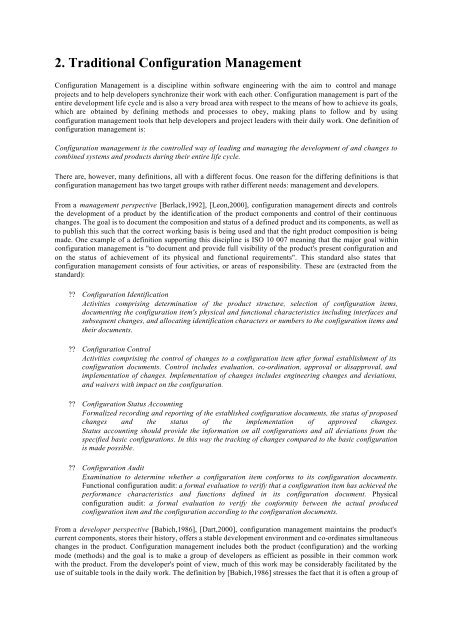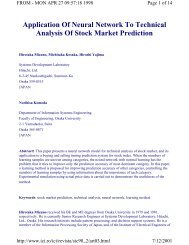Configuration Management for Open Source Software
Configuration Management for Open Source Software - School of ...
Configuration Management for Open Source Software - School of ...
- No tags were found...
You also want an ePaper? Increase the reach of your titles
YUMPU automatically turns print PDFs into web optimized ePapers that Google loves.
2. Traditional <strong>Configuration</strong> <strong>Management</strong><br />
<strong>Configuration</strong> <strong>Management</strong> is a discipline within software engineering with the aim to control and manage<br />
projects and to help developers synchronize their work with each other. <strong>Configuration</strong> management is part of the<br />
entire development life cycle and is also a very broad area with respect to the means of how to achieve its goals,<br />
which are obtained by defining methods and processes to obey, making plans to follow and by using<br />
configuration management tools that help developers and project leaders with their daily work. One definition of<br />
configuration management is:<br />
<strong>Configuration</strong> management is the controlled way of leading and managing the development of and changes to<br />
combined systems and products during their entire life cycle.<br />
There are, however, many definitions, all with a different focus. One reason <strong>for</strong> the differing definitions is that<br />
configuration management has two target groups with rather different needs: management and developers.<br />
From a management perspective [Berlack,1992], [Leon,2000], configuration management directs and controls<br />
the development of a product by the identification of the product components and control of their continuous<br />
changes. The goal is to document the composition and status of a defined product and its components, as well as<br />
to publish this such that the correct working basis is being used and that the right product composition is being<br />
made. One example of a definition supporting this discipline is ISO 10 007 meaning that the major goal within<br />
configuration management is "to document and provide full visibility of the product's present configuration and<br />
on the status of achievement of its physical and functional requirements". This standard also states that<br />
configuration management consists of four activities, or areas of responsibility. These are (extracted from the<br />
standard):<br />
?? <strong>Configuration</strong> Identification<br />
Activities comprising determination of the product structure, selection of configuration items,<br />
documenting the configuration item's physical and functional characteristics including interfaces and<br />
subsequent changes, and allocating identification characters or numbers to the configuration items and<br />
their documents.<br />
?? <strong>Configuration</strong> Control<br />
Activities comprising the control of changes to a configuration item after <strong>for</strong>mal establishment of its<br />
configuration documents. Control includes evaluation, co-ordination, approval or disapproval, and<br />
implementation of changes. Implementation of changes includes engineering changes and deviations,<br />
and waivers with impact on the configuration.<br />
?? <strong>Configuration</strong> Status Accounting<br />
Formalized recording and reporting of the established configuration documents, the status of proposed<br />
changes and the status of the implementation of approved changes.<br />
Status accounting should provide the in<strong>for</strong>mation on all configurations and all deviations from the<br />
specified basic configurations. In this way the tracking of changes compared to the basic configuration<br />
is made possible.<br />
?? <strong>Configuration</strong> Audit<br />
Examination to determine whether a configuration item con<strong>for</strong>ms to its configuration documents.<br />
Functional configuration audit: a <strong>for</strong>mal evaluation to verify that a configuration item has achieved the<br />
per<strong>for</strong>mance characteristics and functions defined in its configuration document. Physical<br />
configuration audit: a <strong>for</strong>mal evaluation to verify the con<strong>for</strong>mity between the actual produced<br />
configuration item and the configuration according to the configuration documents.<br />
From a developer perspective [Babich,1986], [Dart,2000], configuration management maintains the product's<br />
current components, stores their history, offers a stable development environment and co-ordinates simultaneous<br />
changes in the product. <strong>Configuration</strong> management includes both the product (configuration) and the working<br />
mode (methods) and the goal is to make a group of developers as efficient as possible in their common work<br />
with the product. From the developer's point of view, much of this work may be considerably facilitated by the<br />
use of suitable tools in the daily work. The definition by [Babich,1986] stresses the fact that it is often a group of




